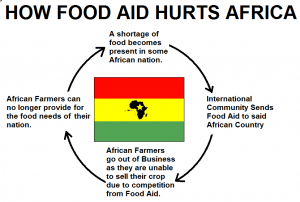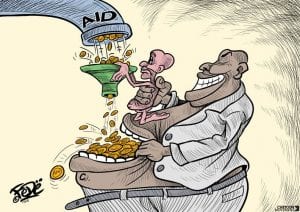Have You Ever Thought About Where Your Donations Are Actually Going?
Oftentimes people donate material items to fulfill a perceived pressing need in the moment, but this type of giving can do more harm than good. In reality, people’s good intentions are meant to help developing countries progress towards the eradication of poverty, but may in actuality inhibit progress towards escaping poverty. This leads to the creation of dependency for both the people and the government of the poor country on donations, and creates a cycle which hinders self-sufficiency necessary for economic and individual success.
**Visual edited by Melissa. Click to see original.
Effect on local businesses and entrepreneurship
Those with money or power often believe that they can do good by filling some need with material things or simply monetary gifts. While in the short term this may be helpful, this kind of aid is ultimately detrimental to the recipients. When donations of some material are sent to an area, this automatically erases the need to produce or sell the same object locally. This, therefore, is detrimental to local businesses and takes away the opportunity for individual entrepreneurship.
The Example of Haiti:
→ Africa and other areas of widespread poverty are often used as a dumping ground for the unwanted goods of privileged westerners.
→ After Hurricane Katrina, millions of old t-shirts were donated to Haiti to aid those who had lost all of their possessions (including clothing).
→ When villages are given thousands of donated t shirts, it takes away the demand for making and selling clothes by local people.
→ This reduces opportunity for jobs and therefore does nothing to improve the lives of these people in the future, perpetuating the cycle of poverty that it is ultimately our intention to break.
Interesting Articles to Consider:
http://content.time.com/time/world/article/0,8599,1987628,00.html
http://www.cnn.com/2013/04/12/business/second-hand-clothes-africa/index.html
From Dependency to Self Sufficiency
Charity and donations often help the recipients put a “band-aid” over their true problems. It then causes the recipients to become dependent on aid and inhibit their self sufficiency that they are capable of. In addition, charity undermines a recipients efforts in generating their own profits. This especially affects the people the most, because with other countries donating items or money, the people are not moving towards the progress of getting out of poverty.
TOMS Shoes Donations = No Good
Business Model: Donate 1 pair of TOMS shoes to children in need around the world, for every pair of shoes that are sold.
 TOMS Intentions: Providing children with a pair of shoes for the rest of their lives.
TOMS Intentions: Providing children with a pair of shoes for the rest of their lives.
What TOMS is Indirectly Promoting: By donating one pair of TOMS shows to a child in need, TOMS is creating dependency between the people and TOMS shoes. In addition, they are implying that TOMS wants people in poverty to be without shoes for the rest of their lives. TOMS donating these shoes ignores the reality that “no one in Haiti wants to be a beggar for life.” The donation of TOMS is hindering the capability of developing countries to pick themselves out of poverty. Although the intentions of TOMS were good, it sends the message to Haitians that they want them to be dependent on TOMS shoes.
Solution: Instead of the “giving fish, rather than training fisherman” archetype, TOMS should set up factories in developing countries to give more job opportunities, allowing residents to buy shoes and not just receive them as donations.
Unwanted Donations
Actual effects: Inhibiting their capability to further grow and progress their industries. In addition, some East African governments feel that by exporting donations, the U.S is undermining their efforts to build their own domestic textile industries.
Voice of the People: Countries no longer want “foreign hand-me-downs dumped” on them because they are trying to be self-sufficient and produce their own clothes. However, they feel as though they as though the U.S is putting them at a disadvantage and restricting their ability to manufacture their own clothes.
Solutions: Stop donating clothes to organizations and agencies that end up selling them to buyers in developing countries. Governments in East Africa are planning to “impose an outright ban by 2019.”
Where Aid Really Goes
A transnational team of journalists “found that the aid projects had all been captured by the elites, whilst the poor were no better off, and sometimes actually poorer than before.”
-“How Aid Helps the Rich Get Richer” by Benon Herbert Oluka, Chief Bisong Etahoben, Francis Mbala, Eric Mwamba, Selay Kouassi, Ken Opala
“In 2012, the last year of recorded data, developing countries received a total of $1.3tn, including all aid, investment, and income from abroad. But that same year some $3.3tn flowed out of them. In other words, developing countries sent $2tn more to the rest of the world than they received.”
–“Aid in reverse: how poor countries develop rich countries” by Jason Hickel
“These so-called “illicit financial flows” amount to around 6.1 percent of the continent’s entire gross domestic product (GDP) – or three times what Africa receives in aid.”
–“Africa is not poor, we are stealing its wealth” by Nick Dearden
(Foreign Aid: Are we really helping others or just ourselves?) – great TED TALK: good numbers showing how richer countries get richer
(Does Aid REALLY Help people?) – shows charity clothes going to waste and how the aid workers are not giving the people what they really need
All in all, the world needs to change their way of humanitarian and foreign aid. We cannot just throw free things at people because most of the time that is not what they need or want. On the other hand, we shouldn’t be throwing aid at them either. The aid only makes the country giving the aid richer, and the country receiving it poorer. This is obviously a corrupt system and something needs to be changed.
– Maddie Major, Elizabeth Kolaski, Melissa Shaw-Patino










This leads to the creation of dependency for both the people and the government of the poor country on donations, and creates a cycle which hinders self-sufficiency necessary for economic and individual success.
his reduces opportunity for jobs and therefore does nothing to improve the lives of these people in the future